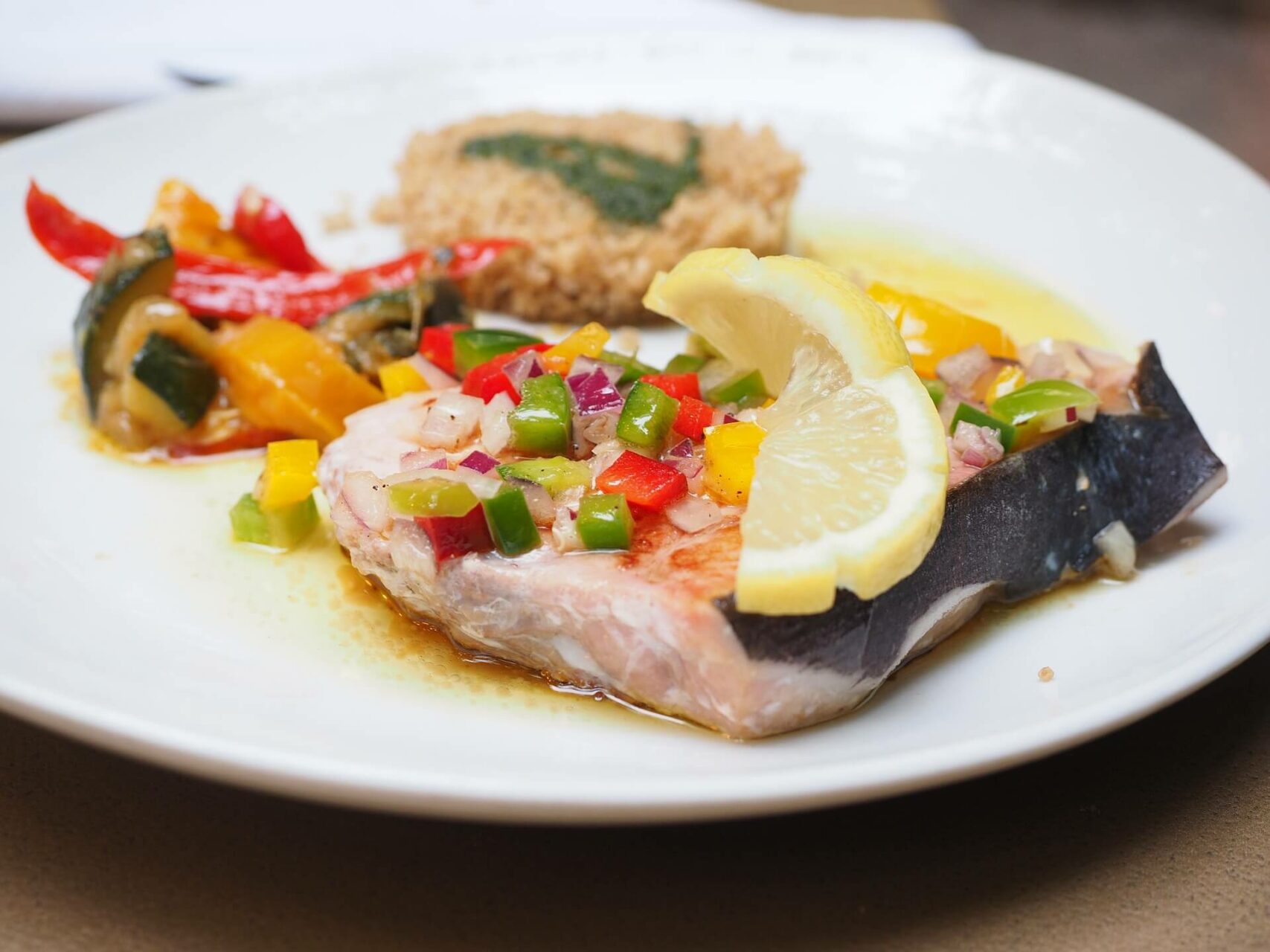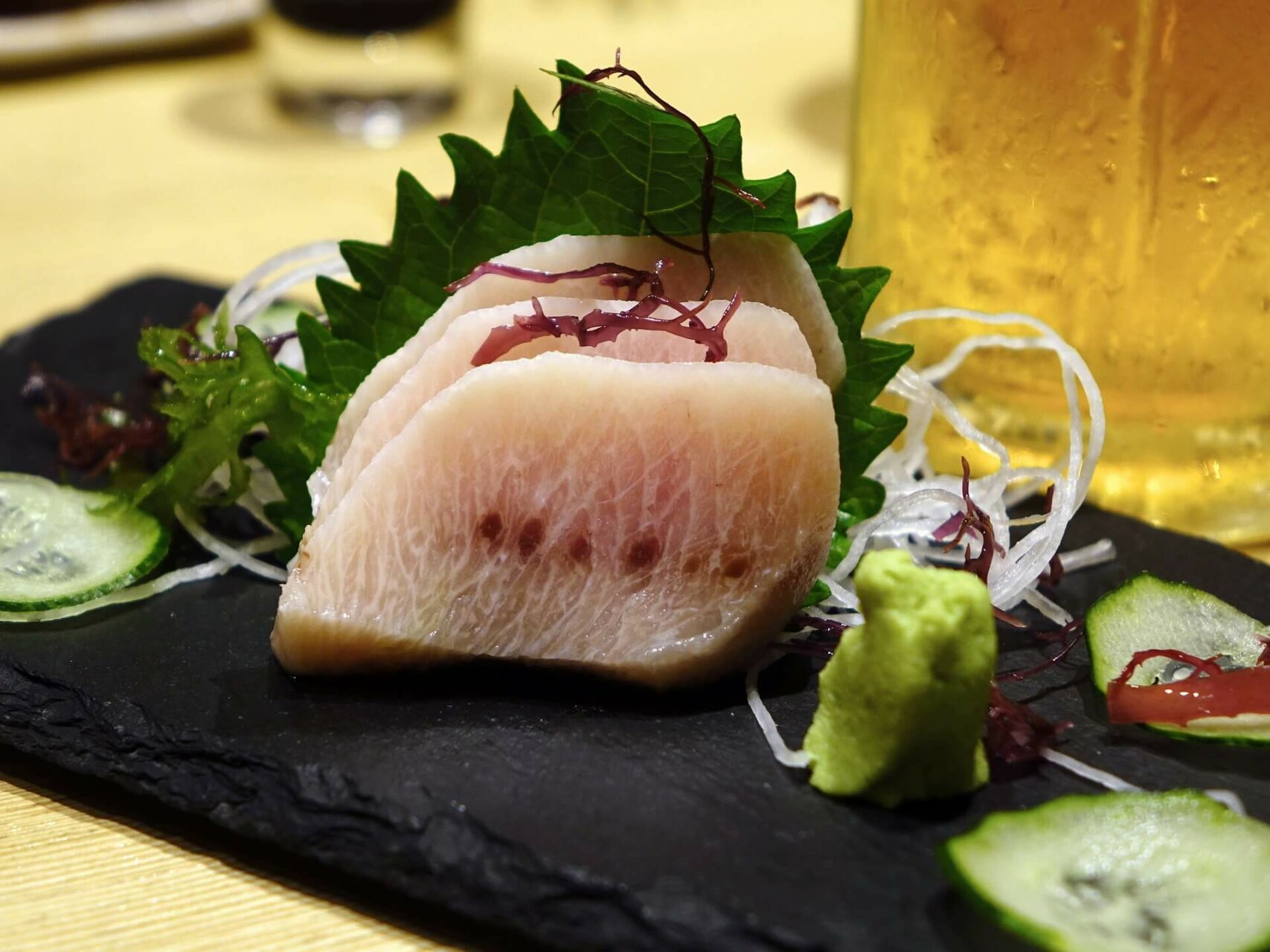Last updated on May 24th, 2023
- What Does Trout Taste Like: Unraveling the Flavor Mysteries - August 2, 2023
- Best Fishing Bibs Tested & Reviewed: Buyer’s Guide - July 19, 2023
- Fishing for Whiskers: Best Bait for Catfish - July 12, 2023
Many fishermen and women, particularly those just beginning to pursue this grand species, often wonder if marlin is edible. In this guide, we will examine the flavor of marlin meat, its health benefits, and how to cook it correctly.
We’ll also explore the differences between blue and black marlin, their physical characteristics, habitat range, and various fishing techniques used in catching each species. Furthermore, we’ll discuss where these fish live by examining their geographic distribution and migration patterns as well as seasonal availability.
For those curious about eating raw marlin or preparing sashimi-style dishes at home, we will cover safety considerations for consuming raw fish along with popular raw preparations for marlin. Finally, we’ll share some delicious recipe ideas for cooking marlin using different methods such as grilling or broiling.
So join us on this culinary journey to discover if you can eat marlin while learning everything there is to know about this fascinating fish!


Table of Contents:
- What Does a Marlin Taste Like?
- Can You Eat Marlin Raw?
- Recipe Ideas
- Difference Between Blue and Black Marlin
- Where Do Marlin Live?
- Frequently Asked Questions
- Conclusion
What Does Marlin Taste Like?
If you’re an angler or a seafood enthusiast, you’ve likely encountered marlin on the menu or at your local fish market – so are Marlin good to Eat? In this section, we’ll dive into the flavor profile of this species and explore how to cook it for maximum enjoyment.


Texture and Flavor Profile
Marlin has a firm texture that’s similar to tuna or swordfish but with a slightly milder flavor. The meat has a tenderness that makes it suitable for various cooking techniques, such as grilling, broiling, baking or even consuming raw in sushi recipes. Its mild taste allows for versatile seasoning options – from simple salt and pepper to more exotic spices and marinades.
How to Cook Marlin
When cooking marlin, be mindful not to overcook it as its low-fat content can cause the meat to become dry quickly if left on heat too long. Here are some popular methods:
- Grilling: Preheat your grill on high heat before placing seasoned marlin steaks directly onto the grate; cook each side for about 4-5 minutes until opaque throughout.
- Pan-searing: Heat oil in a skillet over medium-high heat; sear marinated fillets for approximately 4 minutes per side until cooked through.
- Baking: Place seasoned steaks in an oven-safe dish; bake at 400°F (200°C) for around 15-20 minutes depending on thickness.
Health Benefits of Eating Marlin
In addition to being deliciously satisfying, marlin offers numerous health benefits as it’s packed with protein, omega-3 fatty acids, and essential vitamins and minerals. Marlin intake may be associated with enhanced cardiovascular health, lessened irritation, cognitive functioning improvements, and general well-being.
Marlin has a mild, delicate flavor that pairs well with light sauces and seasonings. Its firm texture makes it ideal for grilling or pan-frying. Let’s explore the distinctions between blue and black marlin to aid you in picking which one is most suitable for your next angling excursion.
Key Takeaway:
The topic is about whether or not marlin can be eaten. It’s a common question among fishermen and those who enjoy recreational fishing. Some may question the safety of eating marlin, while others may be intrigued by its flavor.


Can You Eat Marlin Raw?
If you’re a fan of sushi or sashimi, you might be wondering if it’s safe to eat marlin raw. The answer is yes, but with some important safety considerations in mind. In this section, we’ll explore the precautions to take when consuming raw marlin and discuss popular preparations for enjoying this fish in its uncooked form.
Safety Considerations for Eating Raw Fish
Consuming uncooked marlin carries the potential for contracting parasites and bacteria that can lead to foodborne diseases. To minimize these risks when eating raw marlin, follow these guidelines:
- Source your fish from reputable suppliers who adhere to strict handling and storage practices.
- Ensure the marlin has been properly frozen at -4°F (-20°C) for at least seven days before consumption – this helps kill off most parasites.
- Maintain proper hygiene by washing your hands thoroughly before handling the fish and using clean utensils during preparation.
Popular Raw Preparations for Marlin
Marlin’s firm texture makes it an excellent candidate for various raw dishes that showcase its unique flavor profile:
- Sashimi: Thinly sliced pieces of fresh marlin served with soy sauce, wasabi paste, and pickled ginger make a delicious sashimi dish.
- Poke Bowls: Inspired by Hawaiian cuisine, poke bowls feature cubed pieces of raw marlin mixed with ingredients like avocado, cucumber, and green onions, all tossed in a flavorful sauce. Serve over rice or greens for a satisfying meal.
- Ceviche: This Latin American dish consists of marinated raw fish cooked in citrus juices, such as lime or lemon. Add chopped onions, peppers, cilantro, and other seasonings to create a zesty appetizer or main course.
Nutritional Benefits of Eating Raw Fish
Eating raw marlin can provide some nutritional benefits that are preserved when the fish is not exposed to high heat during cooking:
- The protein content remains intact – marlin is an excellent source of lean protein.
- Fatty acids like omega-3s are less likely to break down when consumed raw.
- Vitamins and minerals present in the fish may be better retained without exposure to heat.
Despite the potential benefits, consuming raw seafood must be done cautiously to ensure safety. Always prioritize safety by following proper handling guidelines outlined earlier in this section.
Eating marlin raw is not for everyone, but it can be a delicious and nutritious option when prepared properly. For those who would rather cook their marlin, the next section provides some tasty recipe ideas.


Recipe Ideas for Cooking Marlin
Are you ready to dive into the world of marlin recipes? We’ve got your back. Whether you’re a seasoned chef or just starting out in the kitchen, these delicious and easy-to-follow recipe ideas will have you cooking up a storm with this versatile fish. Let’s get cooking.
Grilled or Broiled Marlin Recipes
Nothing beats the smoky flavor of grilled marlin, especially when it’s cooked to perfection on an open flame. Broiling is another great way to get that scrumptious flavor if grilling isn’t an option.
- Grilled Marinated Blue Marlin: This simple yet flavorful marinade combines soy sauce, lemon juice, olive oil, garlic, and ginger for a tasty twist on traditional grilled fish.
- Broiled Blackened Fish: Spice things up with this blackening seasoning mix that can be easily adapted for use with marlin fillets.
Baked or Roasted Marlin Recipes
If you prefer oven-cooked dishes over outdoor grilling adventures (or if Mother Nature isn’t cooperating), baked or roasted marlins are equally scrumptious options:
- Baked Marinated Blue Marlin Fillets: Marinate your marlin in a blend of white wine, lemon juice, garlic, and herbs before baking it to tender perfection.
- Herb-Roasted Fish: This versatile recipe works well with any fish fillet, including marlin. The combination of fresh herbs and olive oil creates an aromatic dish that’s sure to impress your dinner guests.
Poached or Steamed Marlin Recipes
For those who prefer lighter cooking methods without sacrificing flavor, poaching or steaming is the way to go:
- Poached Fish with Lemon-Caper Sauce: A tangy sauce made from lemons and capers adds a burst of brightness to this gently poached marlin dish.
- Asian-Style Steamed Marlin: Infuse your steamed marline with Asian flavors by using ginger, scallions, soy sauce, and sesame oil for an unforgettable meal experience.


Difference Between Blue and Black Marlin
While both blue and black marlins are highly sought-after game fish, they do have some distinct differences that set them apart from each other. This section will explore the dissimilarities between blue and black marlins, including their physical features, living environment, and angling strategies employed to catch them.
Physical Characteristics
The blue marlin (Makaira nigricans) is known for its striking cobalt-blue coloration on top with a silvery-white belly. The blue marlin can reach a maximum length of 14 feet and weigh up to 1,800 pounds. One of the key features distinguishing them from black marlins is their elongated pectoral fins which are pointed at the tips.
Black marlins (Istiompax indica), on the other hand, have a more uniform dark blue or black color throughout their body with faint vertical stripes along their sides when excited or stressed. They’re slightly smaller than blue marlins but still impressive in size – reaching up to 13 feet long and weighing around 1,500 pounds. Black marlins feature pectoral fins that are noticeably different from those of blue marlins; the former’s being shorter and more rounded at their tips.
Habitat and Range
- Blue Marlins: These majestic fish prefer warmer waters near oceanic islands like Hawaii or Bermuda but can also be found throughout tropical regions such as Central America’s Pacific coastlines. They are pelagic creatures, meaning they live in the open ocean and can be found at depths of up to 2,000 feet.
- Black Marlins: Black marlins have a more limited range compared to their blue counterparts. They’re primarily found in the Indo-Pacific region, from East Africa to Australia’s eastern coastlines. Unlike blue marlins that roam deeper waters, black marlins tend to stay closer to shorelines and coral reefs where they hunt for prey.


Fishing Techniques for Catching Each Species
Fishing techniques vary depending on which species you’re targeting; however, both types of marlin are often caught using similar methods like trolling with artificial lures or live bait. Here are some tips specific to each species:
- Blue Marlin: Trolling with large skirted lures is a popular method for catching these fish. You’ll want your lure running deep as blue marlins typically feed below the surface. Using teasers such as dredges or spreader bars can also help attract them towards your bait.
- Black Marlin: Live-bait fishing is highly effective when targeting black marlins since they prefer feeding near shorelines and structures like reefs where smaller fish congregate. Slow-trolling with baits such as skipjack tuna or bonito can yield great results. Additionally, using circle hooks instead of J-hooks increases the chances of a successful catch and release.
The differences between blue and black marlin are numerous, from physical characteristics to habitat preferences. With a better understanding of where marlin live and migrate, anglers can plan trips that target these species more effectively.


Where Do Marlin Live?
Marlins inhabit numerous regions around the globe, and their environment is an important factor in how they behave and move. Let’s dive into the fascinating world of marlins.
Geographic Distribution of Marlin Species
Marlins are predominantly found in tropical and subtropical waters across the globe, making them ideal targets for recreational fishermen. The three primary species – blue marlin (Makaira nigricans), black marlin (Istiompax indica), and striped marlin (Kajikia audax) – have distinct geographic distributions:
- Blue Marlin: Blue marlins inhabit both the Atlantic and Indo-Pacific oceans, with populations extending from North America to South America on either side.
- Black Marlin: Black marlins prefer warmer waters around Southeast Asia, Australia, Central America, East Africa coastlines as well as some Pacific islands.
- Striped Marlin:Their range is primarily within the Indian Ocean but can also be spotted along California’s coastline during certain times of year.
Migration Patterns of Marlin
Apart from having different habitats based on their species type; each individual may migrate seasonally depending upon factors such as water temperature or food availability like other pelagic predators do too. For example:
- Blue marlins in the Atlantic Ocean migrate from North America to South America, following warm currents and prey.
- Black marlins are known for their extensive migrations across the Pacific Ocean, traveling thousands of miles between feeding grounds and spawning areas.
- Striped marlin migration patterns remain somewhat mysterious but have been observed moving between California waters during warmer months while venturing into cooler regions when temperatures drop down south.
Seasonal Availability of Marlin
The best time to target these magnificent fish depends on where you’re fishing as well as which species is your primary goal. Here’s a quick rundown:
- Blue Marlin: In the Atlantic region, blue marlins can be caught year-round with peak seasons varying by location; however, they tend to be more abundant during summer months (June through September).
- Black Marlin: Australia’s Gold Coast sees black marlins from September until December while Central American countries like Costa Rica experience higher numbers around November through March each year.
- Striped Marlin: The striped variety makes its appearance along Californian shores typically October-November timeframe before heading back out into deeper waters come wintertime. So if it’s stripes you’re after, better plan accordingly. No matter which type or season suits your fancy, one thing remains constant: Marlins offer an exhilarating challenge for anglers everywhere – making them true trophies among those who pursue them passionately.
Frequently Asked Questions Can You Eat Marlin
Are marlin good to eat raw?
Yes, marlin can be eaten raw when properly prepared. It is commonly used in dishes like sashimi and poke bowls. However, it’s essential to ensure the fish is fresh and handled correctly to minimize the risk of foodborne illnesses. Consuming raw or undercooked seafood carries a higher risk than cooked fish.
What type of marlin is best to eat?
Blue marlin is considered the best type for consumption due to its tender texture and mild flavor profile. Black marlin has a stronger taste and firmer texture but can still be enjoyable if prepared well. Both species offer health benefits such as high protein content, omega-3 fatty acids, vitamins, and minerals.
Can you eat marlin medium rare?
Yes, you can cook marlin medium-rare by searing it quickly on high heat while leaving the center slightly pinkish-red. This method helps retain moisture within the fish while enhancing its natural flavors without overcooking it. Be sure that your cooking surface reaches an appropriate temperature before adding your fillet.
What are the health benefits of Marlin fish?
- Richest source of lean protein
- Packed with Omega-3 fatty acids which promote heart health
- Vitamins B12 & D contribute to brain function & bone strength
- Selenium supports immune system function & thyroid hormone metabolism
Conclusion on What does Marlin Taste Like
In conclusion, Marlin is a great fish to eat and can be cooked in many different ways. Whether you prefer it raw or cooked, there are plenty of recipes available that will make your taste buds sing. Eating marlin can be a safe and enjoyable experience as long as you take the proper precautions when preparing it. With its distinctive taste and multiple cooking methods, Marlin is sure to be a beloved dish for many years. So don’t hesitate – give this delicious fish a try today.
